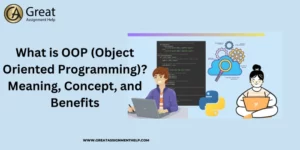Object-Oriented Programming, or OOP, is a way of writing code that simulates real-world objects. It helps developers create software that’s modular, reusable, and easy to maintain. By using OOP, you can build complex applications more efficiently and make them scalable for future growth.
Object-Oriented Programming (OOP) is a basic and popular programming paradigm that plays a key role in software development. If you are a beginner to programming, then you must first strengthen your knowledge of OOP to write error-free source code and become a programming expert. In case you have no idea about OOPS, update your knowledge from this blog. Here, we have explained what is OOP (Object Oriented Programming) and, its meaning, concept, and Benefits.
Continue reading this blog and gain in-depth ideas about Object Oriented Programming concepts.
What is OOP (Object Oriented Programming)?

Object-oriented programming is a computer programming model that designs software based on the concept of objects, instead of functions and logic. In this model, objects refer to a set of data that has unique attributes and behavior. Especially, in OOP, everything will be grouped as self-sustainable objects.
Mostly, the developers use this programming approach for creating, maintaining, and updating large and complex programs. Especially, with OOP, programs for design, manufacturing, and mobile applications can be built. A real-time example of OOP is the automobile simulation software.
The organization of an object-oriented program contributes to the benefits of the methods in the collaborative development of group-based programming projects. A few other advantages of OOP include the reuse of code, efficiency, and scalability.
The first step in the OOP process is data modeling. This stage primarily focuses on the collection of all objects that a programmer wishes to handle and determining how they relate to one another. Note that an object can be anything from a human being with attributes like name and address to simple computer programs like widgets.
After identifying an object, assign it to a class of objects that specifies the type of data it holds and the logic operations that are essential for modification. Here, the method refers to the unique series of logic steps. On the other hand, the objects may communicate with well-defined interfaces called messages.
Also Read: Learn How to Write the Best Quality Programming Assignment
The Standard Structure of Object-Oriented Programming
The following are the pillars or building blocks of OOP
Classes
Classes are the fundamental unit of object-oriented programming. These are user-defined data types. It typically serves as a blueprint or a template for objects, methods, and attributes.
Inside a class, variables, constants, member functions, and other functionality can be defined. It generally integrates data and functions into a single unit. It does not use memory at runtime.
Classes are not a data structure. It is a logical entity and is the best example of data binding. Remember, a class can exist in the absence of an object, but not the other way around.
Objects
Objects are class instances formed with specially designed data. In general, objects are real-world entities that contain unique attributes, properties, and behaviors. The description is the only object defined when the class is first formed.
The object includes member functions and variables defined in the class. Most importantly, the objects occupy a certain space in the memory.
Methods
Methods are functions that define an object’s actions inside a class. A reference to an instance object is the first step in any method that is specified in class declarations. In addition, instance methods refer to the subroutines that are part of an object. Programmers employ methods to maintain functionality contained within a single object at a time or to allow for reusability.
Attributes
In the class template, the attributes represent an object’s state. Usually, the attributes field will contain data for objects. Furthermore, class attributes will have a strong relationship with the class itself.
Key Principles and Concepts of Object-Oriented Programming
The object-oriented programming model works completely based on 4 main principles- Encapsulation, Abstraction, Inheritance, and Polymorphism.
If you wish to use an object-oriented programming paradigm, then you must have a good comprehension of the concepts involved in it.
Here, let us look in detail at the major OOP concepts and principles.
Encapsulation
Encapsulation is the process of joining data and functions into a single entity. But, here, to access these data members, the scope of the member function needs to be set to “public” and the scope of the data members needs to be set to “private”.
According to this principle, an object includes all relevant information, of which the external world can see only a small portion. Every object contains a private class that includes its state and implementation.
Encapsulation guards against unauthorized usage and outside interference with data and services. As a result, security is also provided.
Abstraction
Abstraction is one of the essential concepts in object-oriented programming. It is the act of describing important features without providing supporting information.
Typically, abstraction is a method that creates a completely new data type that is suitable for a certain application. It avoids unnecessary information and only displays the exact section that the user has requested. Abstraction is important because it prevents developers from doing the same task over and over again.
Inheritance
Inheritance is the process of obtaining properties. Especially, in OOP, an object passes properties to another object. Moreover, by establishing links and subclasses between objects, developers can reuse similar functionality and maintain a clear hierarchy. This feature of OOP accelerates development and improves accuracy by necessitating a more thorough analysis of the data.
Typically, inheritance is the process of inheriting the properties of an existing parent class by a newly created child class. Hence, through inheritance, the parent-child relationship can be represented. Also, inheritance provides code reusability.
Polymorphism
Polymorphism allows many classes to utilize the same method name. However, it also requires redefining methods for derived classes. There are two types of polymorphism: run-time polymorphism and compile-time polymorphism.
In addition to having multiple forms, objects will have common behaviors. Particularly, to avoid writing redundant code, every time an object from a parent class is used, the program will identify which usage or meaning is needed.
Coupling
The term “coupling” in object-oriented programming refers to the division of concerns. It implies that one object cannot directly alter another object’s state or behavior. Also, it describes the degree of connection between two objects. Tight coupling and loose coupling are the two different forms of coupling.
Loosely connected objects are those that are unrelated to one another and do not directly alter the state of other objects. The code is more adaptable, malleable, and simpler to deal with when there is loose coupling.
Tightly connected objects are those that are dependent on other items and can change the states of other objects. It establishes a situation in which altering the code of one thing necessitates altering the code of other objects. Since it is unable to divide the code into a tight coupling, code reuse may be challenging.
Cohesion
Cohesion in OOP describes how well the elements of a module fit together. It quantifies how strongly the module and data are related. In simple terms, coherence is the clarity of a module’s responsibilities. It is frequently contrasted with coupling.
Typically, cohesion specifies how a single module or class is intended to be used. The object-oriented design improves as the module or class’s coherence increases.
High and Low are the two types of cohesion. High cohesiveness has a connection with various necessary software properties, including robustness, dependability, and understandability. Low cohesiveness is related to undesirable characteristics such as being difficult to maintain, test, reuse, or even comprehend.
Association
An association is a process that creates a relationship between two distinct classes with the use of their objects. In general, associations can be one-to-one, one-to-many, many-to-one, or many-to-many. An association is a link between two entities.
Remember, an object can have one or more associations. Moreover, both unidirectional and bidirectional relationships are possible.
Aggregation
It is an advanced type of association in which each item has its lifecycle. However, ownership prohibits the child object from becoming a component of another parent object.
Java aggregation displays a weak association between an entity and its contents. This demonstrates the relationship between a component and a whole, in which a part can live without the whole.
When unconnected objects are united, they form a unique semantically weak connection type known as an aggregation.
Composition
Composition is a form of association that represents the relationship between a component and a whole, in which a part cannot exist without the whole. There are several ways to aggregate, one of which is composition.
Since they don’t have a lifecycle, child objects all vanish together with the parent object. In any composition between two entities, one cannot exist without the other. As a result, the makeup of both entities is dependent upon the other.
Modularity
Modular design is the split of a system into multiple functional sections (modules) that can be merged to form a larger application. Modularity and encapsulation have an intrinsic connection. Especially when transferring encapsulated abstractions into actual, physical modules, modularity is defined as high module cohesion and little inter-module interaction or coupling.
Constructors
A constructor is a type of subroutine that plays a key role in generating an object. It initializes the new object for use. Also, it typically takes constructor arguments to initialize member variables. In OOP, a method is a process that has an association with a message and an object.
The interface of an object consists of its state data and behavior, which specify how any of its countless customers can use it. A method is an object activity with consumer parameters.
Also Read: A Beginner’s Guide to Sequel Programming Languages
Benefits of Object-Oriented Programming
OOP is popular in the programming world because of its advantages. Here, let us look at the advantages of object-oriented programming.
- Permits the reuse of code
- Boosts software development productivity
- Simplifies troubleshooting
- Strengthens security
- Makes code maintenance easier
- Reduces data repetition
- Lead to flexible code
- Early problem-solving
- Offers design advantages.
- Reduces the development costs.
List of Object-Oriented Programming Languages
Pure OOP Languages are
- Ruby
- Scala
- Emerald
- Jade
The programming languages that are designed exclusively for OOP are
- C++
- Python
- Java
Other programming languages that pair with OOP are
- PHP
- Visual Basic .NET
- JavaScript
Also Read: Get to Know about Low-Level Programming Language Examples
Applications of Object-Oriented Programming
The following are some applications that use the OOP model.
- User-interface design, such as Windows
- Object-oriented database
- Computer graphics applications
- Real-time systems
- Simulation and modeling software
- Client-Server System
- CAD/CAM Software
- Artificial Intelligence System
- Office automation system
Also Read: 10 Most Popular Programming Languages 2024
Conclusion
Hopefully, by now, you will have gained a better understanding of what OOP (Object Oriented Programming) is and its meaning, concept, and benefits. But to further strengthen your knowledge of the OOP concept, you must practice writing the source code. Otherwise, you can also utilize our programming assignment help services. When you take our services, the programming experts from our team will assist you in enhancing your subject comprehension and coding skills.



